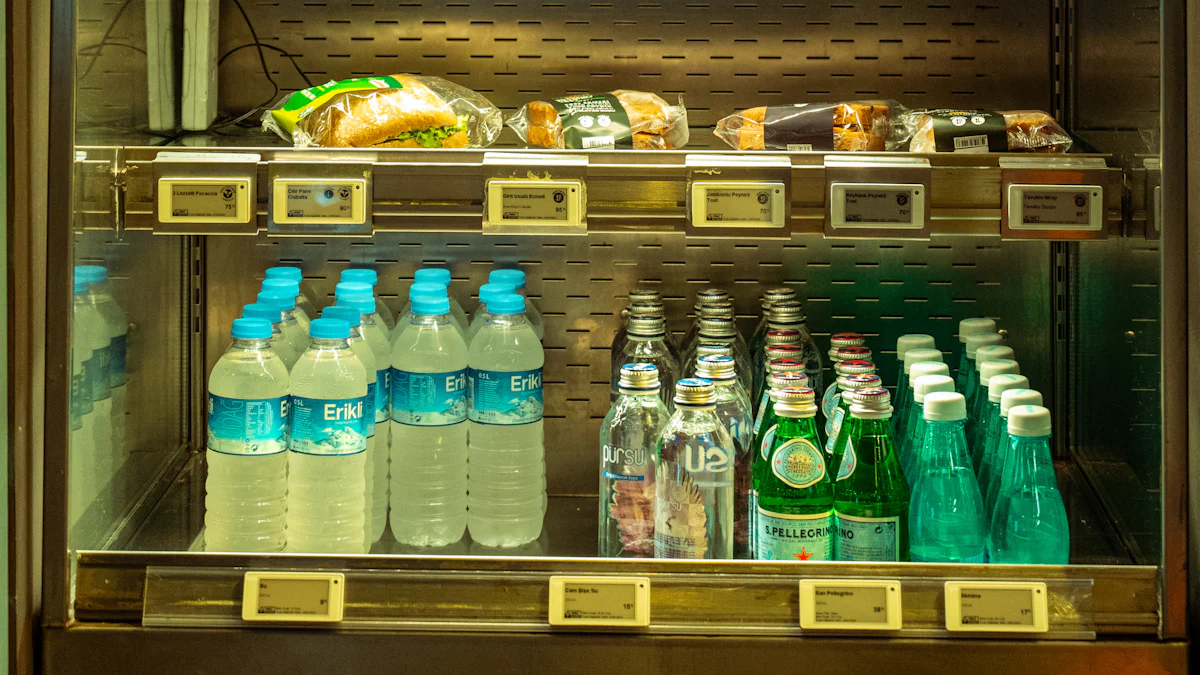Essential Tips for Maintaining a 3-Layer Refrigerated Display Cabinet in 2025

Maintaining a 3-layer folding refrigerated display cabinet with hood design ensures consistent performance and hygiene. I’ve seen how regular upkeep of the refrigerated display cabinet reduces energy consumption and extends its lifespan. Simple practices like cleaning door seals and defrosting coils prevent cold air leakage. In 2025, evolving standards like energy efficiency and eco-friendly refrigerants make maintenance even more critical for adapting to modern demands.
Key Takeaways
- Clean your refrigerated display cabinet often to keep it safe. Do daily cleaning and deep clean once a month.
- Check the temperature and humidity levels regularly. Keep the temperature at 35°F to 41°F. Humidity should stay between 60% and 70% to keep food fresh.
- Look at parts like door seals and coils often. Fixing them stops cold air from escaping and saves energy and money.
Cleaning and Hygiene Practices

Daily Cleaning Routine
I always start my day by ensuring the 3-layer folding refrigerated display cabinet with hood is spotless. A quick daily cleaning routine keeps the cabinet hygienic and visually appealing. Here’s what I do:
- I disassemble the shelves and clean them with warm soapy water. Once dry, I reinsert them.
- I wipe down the interior surfaces with a mild detergent and a soft cloth, paying special attention to door seals and glass surfaces.
- For the glass, I use a streak-free cleaner to maintain clarity and visibility.
- To eliminate bacteria and odors, I sanitize the interior with a food-safe solution.
This routine not only ensures hygiene but also prevents the buildup of grime and bacteria.
Deep Cleaning Schedule
While daily cleaning is essential, I schedule a deep cleaning session every month. During this process, I defrost the cabinet to remove any ice buildup. I also clean the drainage system to prevent clogs and odors. This step is crucial for maintaining the efficiency of the 3-layer folding refrigerated display cabinet with hood. Regular deep cleaning ensures the cabinet operates at peak performance and extends its lifespan.
Recommended Cleaning Tools and Products
Using the right tools and products makes cleaning more effective. I recommend the Kaivac Refrigerated Case Cleaner for its built-in pressure washer and wet vacuum. It’s perfect for tackling tough grime while protecting the cabinet’s components. For daily use, I stick to:
- Mild detergents and soft cloths for wiping surfaces.
- Warm soapy water for cleaning shelves.
- Food-safe sanitizers to keep the interior free from bacteria.
These tools and products help me maintain the cabinet’s hygiene without compromising its performance.
Temperature and Humidity Management

Setting and Monitoring Optimal Temperature
I always prioritize setting the correct temperature for my 3-layer refrigerated display cabinet. Keeping the temperature between 35°F and 41°F ensures food stays fresh and safe. I use a digital thermometer to monitor the temperature daily. This tool helps me quickly spot any fluctuations that could compromise food quality.
To maintain consistency, I avoid placing the cabinet near heat sources like ovens or direct sunlight. These factors can cause the internal temperature to rise, making the compressor work harder. I also ensure the air vents inside the cabinet remain unobstructed. Proper airflow prevents uneven cooling and keeps the temperature stable.
Managing Humidity Levels
Humidity control is just as important as temperature management. High humidity can lead to condensation, while low humidity may dry out food. I aim for a humidity level of 60% to 70% inside the cabinet. To achieve this, I use a hygrometer to measure humidity levels regularly.
When I notice excess moisture, I check the door seals for leaks and clean the drainage system. These steps help reduce condensation. For dry conditions, I place a shallow tray of water inside the cabinet to increase humidity naturally.
Tools for Temperature and Humidity Control
Using the right tools makes managing temperature and humidity easier. I rely on:
- Digital thermometers for accurate temperature readings.
- Hygrometers to monitor humidity levels.
- Smart sensors that send alerts to my phone if conditions change.
These tools help me maintain an optimal environment, ensuring my refrigerated display cabinet operates efficiently and preserves food quality.
Component Inspection and Maintenance
Inspecting and Replacing Door Seals
I always check the door seals of my 3-layer folding refrigerated display cabinet with hood for signs of wear and tear. Damaged seals can cause cold air to escape, leading to higher energy consumption and inconsistent cooling. Here’s what I look for:
- Tears, cracks, or other visible damage.
- Food particles or residue stuck in the seals.
- Any debris that might prevent a proper seal.
To keep the seals in good condition, I clean them regularly with warm water and mild detergent. This simple step removes dirt and ensures the seals remain flexible. If I notice any damage, I replace the seals immediately. A proper seal is essential for maintaining the cabinet’s efficiency and keeping food fresh.
Cleaning and Maintaining Coils
The coils play a crucial role in the cooling process. Dirty coils can reduce efficiency and strain the compressor. I clean the coils every three months to prevent dust and grime buildup. Using a soft brush or a vacuum cleaner with a brush attachment, I gently remove dirt from the surface. I also ensure the area around the coils is free from obstructions to allow proper airflow. Regular coil maintenance keeps the cabinet running smoothly and reduces energy costs.
Ensuring Compressor Efficiency
The compressor is the heart of the refrigerated display cabinet. I inspect it regularly for unusual noises or signs of damage. Proper ventilation around the cabinet is vital to prevent overheating. I also make sure the doors close tightly to avoid cold air leakage. Defrosting the cabinet periodically helps maintain the compressor’s efficiency. For long-term savings, I consider upgrading to energy-efficient models when necessary. These practices ensure the compressor operates effectively and extends the cabinet’s lifespan.
Energy Efficiency Tips
Proper Placement of the Cabinet
I always pay close attention to where I place my 3-layer folding refrigerated display cabinet with hood. Positioning it in a cooler area, away from heat sources like ovens or direct sunlight, reduces energy consumption. Studies show that a 1°C increase in room temperature can raise energy usage by 6%. I also ensure the cabinet has enough space around it for proper ventilation. This prevents the compressor from overworking.
To maximize efficiency, I regularly check that the doors close tightly. Proper door closure prevents cold air leakage, which helps maintain consistent cooling. I also defrost the cabinet periodically to avoid ice buildup, which can strain the system.
Minimizing Door Openings
I make it a habit to minimize how often I open the cabinet doors. Each time the doors open, warm air enters, forcing the refrigeration system to work harder. According to the U.S. Department of Energy, warm air infiltration accounts for up to 80% of the heat load in open display cases. By keeping the doors closed as much as possible, I reduce energy waste and maintain a stable internal temperature.
This practice also improves customer comfort by preventing cold drafts in the surrounding area. In colder climates, it even reduces the burden on the heating system.
Upgrading to Energy-Saving Features
I’ve noticed that upgrading to modern energy-saving features makes a significant difference. Many cabinets now include LED lighting, which consumes less power and generates less heat. Smart technologies, like IoT-enabled sensors, allow me to monitor and adjust settings remotely. These features help me optimize energy use and reduce maintenance costs.
I also look for cabinets that use eco-friendly refrigerants. These refrigerants have a lower global warming potential, which aligns with sustainability goals. By investing in these advancements, I ensure my cabinet operates efficiently while reducing its environmental impact.
Safety Precautions
Electrical Safety Guidelines
Electrical safety is a priority when maintaining a refrigerated display cabinet. I always ensure the electrical installation and equipment are safe to use. Regular maintenance prevents potential hazards.
A 19-year-old man was electrocuted and killed when he touched a refrigerated display cabinet in a café. Investigation showed that the 13A plug had been incorrectly refitted to the cabinet’s main lead. This meant the metalwork of the cabinet, which should have been safe to touch, was dangerously live at mains voltage.
To avoid such incidents, I follow these practices:
- Conduct visual checks for damaged wires or plugs.
- Remove equipment from use immediately if I notice any damage.
- Schedule professional inspections to ensure all electrical components meet safety standards.
These steps help me maintain a safe environment for both staff and customers.
Food Safety Practices
Maintaining food safety is essential for hygiene and customer health. I always store food in proper packaging to prevent cross-contamination. Monitoring the cabinet’s temperature daily ensures food stays within safe limits.
Here’s what I do to maintain food safety:
- Remove spoiled or expired items promptly.
- Clean and sanitize the cabinet regularly using food-safe solutions.
- Wipe down surfaces with a mild detergent to eliminate bacteria and odors.
These practices keep the cabinet clean and the food safe for consumption.
Avoiding Overloading the Cabinet
Overloading the cabinet reduces cooling efficiency and risks food spoilage. I avoid overcrowding by leaving enough space for air circulation. Proper airflow ensures even cooling and prevents strain on the compressor.
By following these precautions, I keep my refrigerated display cabinet safe, efficient, and reliable.
Troubleshooting Common Issues
Resolving Temperature Fluctuations
I often notice temperature fluctuations in my refrigerated display cabinet when airflow is blocked or the thermostat malfunctions. To fix this, I start by checking the air vents inside the cabinet. Obstructions like food packaging or debris can restrict airflow, so I clear them immediately. I also inspect the thermostat settings to ensure they match the recommended range of 35°F to 41°F.
If the problem persists, I examine the door seals for leaks. Damaged seals allow warm air to enter, disrupting the internal temperature. Replacing worn-out seals usually resolves the issue. For consistent monitoring, I rely on a digital thermometer. It helps me detect fluctuations early and take corrective action before they affect food quality.
Fixing Noise Problems
Unusual noises from the cabinet often indicate mechanical issues. When I hear rattling or humming, I inspect the fans and motors first. Vibrations or strange sounds usually mean these components need attention. I clean the fan blades to remove dust and ensure they spin freely. If the noise continues, I consult a professional to check for deeper issues.
Replacing worn-out parts like fans or motors often restores the cabinet’s quiet operation. Regular maintenance prevents these problems from escalating. I also ensure the cabinet is level on the floor, as uneven placement can cause vibrations.
Addressing Condensation Issues
Condensation inside the cabinet can lead to water buildup and food spoilage. I address this by checking the door seals for gaps. Properly sealed doors prevent warm air from entering and forming moisture. Cleaning the drainage system also helps. Blocked drains often cause water to accumulate, so I clear them regularly.
To reduce humidity, I monitor the cabinet’s environment using a hygrometer. If I notice excess moisture, I adjust the humidity levels or place a moisture-absorbing product inside. These steps keep the cabinet dry and maintain food freshness.
Professional Maintenance and Upgrades
When to Seek Professional Help
I always pay attention to signs that indicate the need for professional maintenance. For example, unusual noises or vibrations from the fans and motors often signal deeper mechanical issues. I also inspect the cabinet’s lighting regularly. If the lights flicker or fail, I know it’s time to call a technician. Professional help becomes essential when I suspect refrigerant leaks or notice worn-out components. These issues can lead to costly breakdowns if not addressed early.
Technicians have the expertise to identify hidden problems and take preventive measures. They ensure the cabinet operates efficiently and safely. I never hesitate to seek professional assistance when I encounter issues beyond my expertise. This approach saves time and prevents further damage.
Benefits of Regular Servicing
I’ve learned that regular servicing offers multiple benefits. Technicians can detect potential issues like refrigerant leaks or damaged parts early. This proactive approach minimizes the risk of unexpected failures. It also ensures the cabinet maintains consistent temperatures, which is crucial for preserving food quality.
Routine maintenance extends the lifespan of my 3-layer folding refrigerated display cabinet with hood. It reduces energy consumption, saving me money in the long run. I also appreciate the peace of mind that comes with knowing the cabinet is in optimal condition. Regular servicing keeps it running smoothly and efficiently.
Upgrading to a Modern 3-Layer Folding Refrigerated Display Cabinet with Hood
Upgrading to a modern cabinet has been a game-changer for me. Today’s models come with advanced features tailored to specific applications. For instance, cabinets designed for fresh food supermarkets maintain a stable temperature range of 0–4°C. They also prevent frost and enhance product visibility.
In convenience stores, cabinets with efficient heat dissipation and quick temperature recovery are ideal. They even include wind shields to minimize the impact of hot air. For hotel buffets, modern cabinets stabilize temperatures for cold dishes, even during high-traffic periods. These features make modern cabinets more reliable and energy-efficient.
Investing in an upgraded 3-layer folding refrigerated display cabinet with hood ensures I stay ahead of evolving standards. It also enhances the overall performance and presentation of my products.
Maintaining a 3-layer folding refrigerated display cabinet with hood requires consistent effort. Regular cleaning and sanitization ensure hygiene and functionality. Monitoring temperature and inspecting components help maintain efficiency. These practices extend the cabinet’s lifespan, reduce energy costs, and preserve food quality. Adopting these habits ensures your cabinet operates optimally in 2025 and beyond.
Consistent maintenance reduces energy consumption, prevents costly repairs, and enhances the reliability of refrigerated display cabinets.
FAQ
How often should I clean the coils of my refrigerated display cabinet?
I clean the coils every three months. This prevents dust buildup, ensures proper airflow, and keeps the cabinet running efficiently.
What tools do I need for cleaning the cabinet?
I use mild detergents, soft cloths, food-safe sanitizers, and a vacuum cleaner with a brush attachment. These tools help me maintain hygiene and protect the cabinet’s components.
Can I use any detergent for cleaning the cabinet?
No, I only use mild detergents. Harsh chemicals can damage the cabinet’s surfaces and seals, reducing its efficiency and lifespan.


















